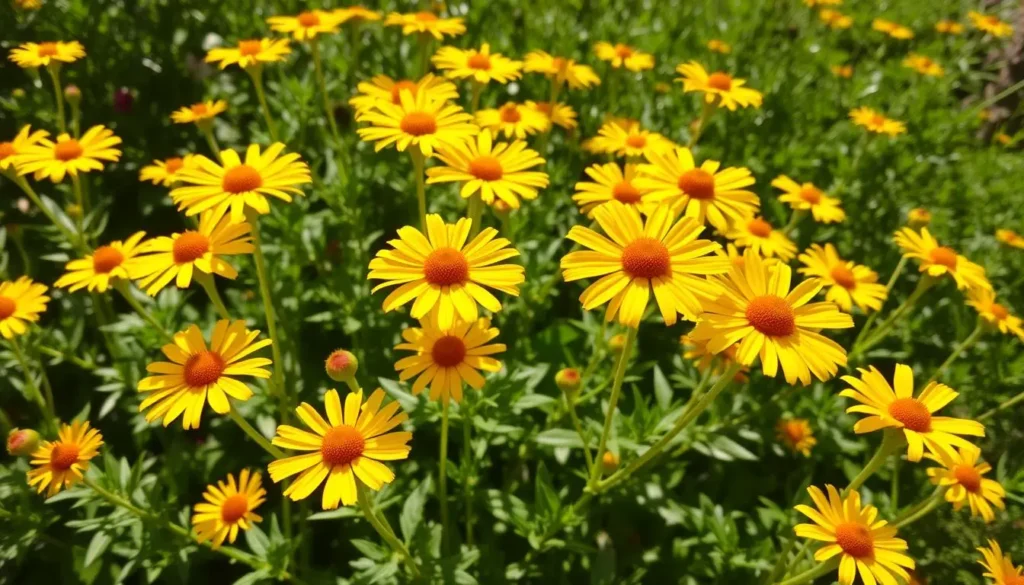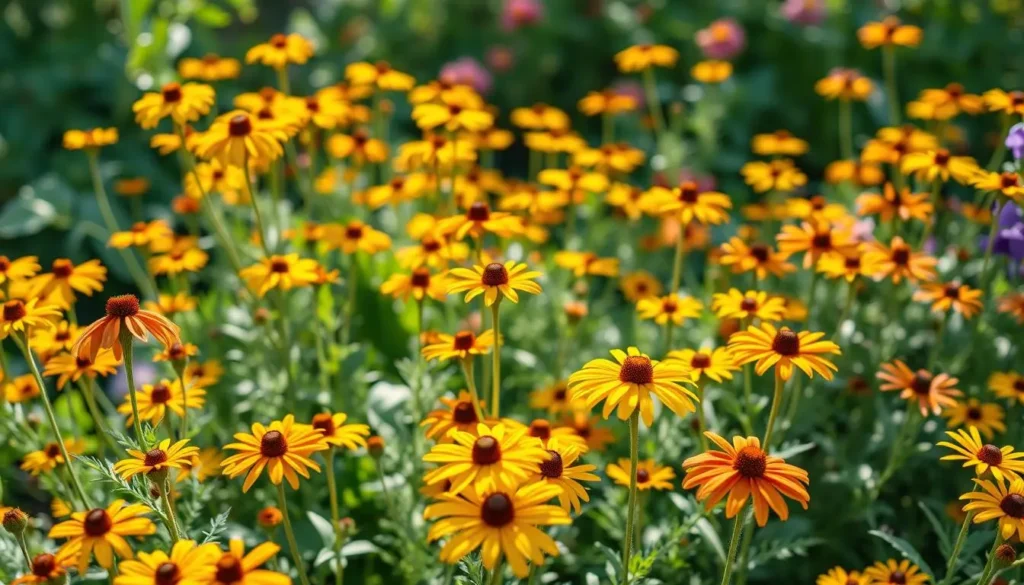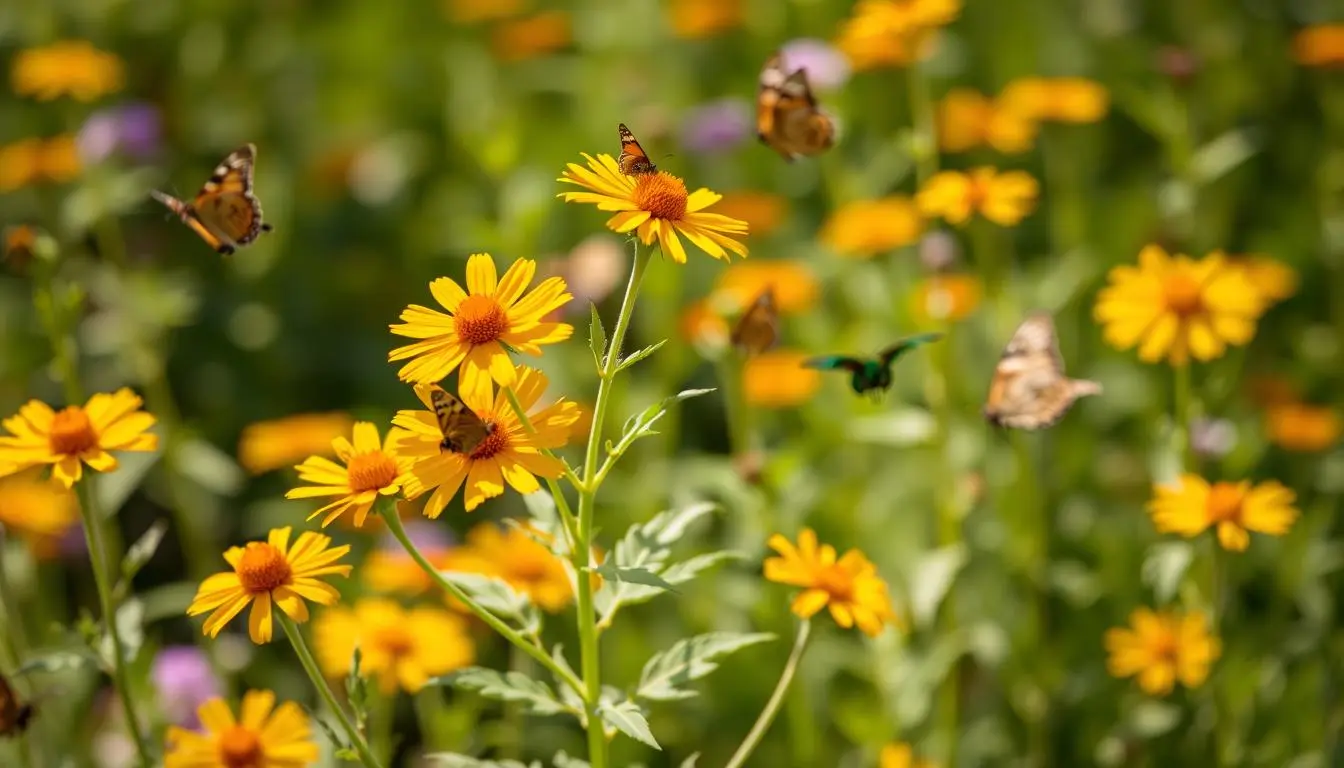When the sun warms the earth, gardens across America burst into color. Tickseed stands out as a star, with its bright yellow flowers. It turns simple outdoor spaces into joyful, beautiful oases.
Known as Coreopsis, tickseed is a beloved garden icon. It thrives in many conditions, from hot summers to cool autumns. This makes it perfect for both new and seasoned gardeners. Tickseed’s endless blooms bring happiness to any garden.
Table of Contents
Understanding Tickseed: A Garden Favorite
Tickseed, also known as Coreopsis, is a vibrant and versatile flower. It has captured the hearts of gardeners across the United States. This cheerful plant boasts a rich history and a diverse array of varieties. It makes it a true standout in any landscape.
Origin and Natural Habitat
Tickseed plants are native to North America. Many species thrive in the wild across the continent. These tickseed flowers are found in various habitats, including prairies, open woodlands, and coastal regions. They show their adaptability to different climates and environments.
Botanical Classification
Botanically, what is a tickseed plant belongs to the genus Coreopsis. It is part of the Asteraceae, or daisy, family. This classification places tickseed alongside other well-known flowers like sunflowers and daisies. They share similar characteristics and growing habits.
Common Varieties
Within the Coreopsis genus, there are numerous popular varieties. Some of the most beloved tickseed cultivars include the delicate ‘Moonbeam’ with its soft yellow blooms. The vibrant ‘Zagreb’ with its golden-orange flowers is also popular. The hardy ‘Sunbright’ is known for its long-lasting display of color.
“Tickseed is a true garden staple, offering a burst of sunshine and versatility that is hard to match.”
Benefits of Growing Tickseed in Your Landscape
Tickseed, also known as Coreopsis, is a favorite perennial. It’s a bright yellow plant that adds beauty to any garden. It’s also very practical for your landscape.
One big plus of tickseed is its long blooming season. It flowers from early summer to fall. This makes it great for keeping your garden colorful for a long time.
Tickseed is also very good at handling drought. It grows well in different soils, making it easy to care for. It’s perfect for both new and established gardens.
Another great thing about tickseed is it attracts butterflies and bees. Its flowers are full of nectar, helping pollinators. This is key for a healthy garden ecosystem.
“Tickseed is a versatile perennial that can elevate any garden with its vibrant colors and low-maintenance characteristics.”
Tickseed fits well in many garden styles. It works in formal beds and natural meadows. Its beauty and adaptability make it a favorite among gardeners.
In short, tickseed offers many benefits for your garden. It blooms for a long time, handles drought well, and attracts pollinators. It’s a true gem that adds joy and beauty to your outdoor space.
Essential Growing Requirements for Healthy Tickseed Plants
To keep tickseed flowers looking their best, knowing their growing needs is key. These tickseed plants do well in certain soils, sunlight, and water.
Soil Conditions and pH Levels
Tickseed plants love soil that drains well and is rich in nutrients. The soil should be slightly acidic to neutral, between 6.0 and 7.0. Sandy or loamy soil is best because it prevents waterlogged roots.
Sunlight and Temperature Needs
For the best growth, tickseed flowers need full sun, at least 6 hours a day. They can handle some shade, but might not bloom as much. The ideal temperature is between 65°F and 80°F.
Water Requirements
- Tickseed plants need about 1 inch of water a week, from rain or a hose.
- Don’t overwater, as it can cause root rot. Let the soil dry a bit between waterings.
- In hot, dry weather, water more often to keep the soil moist and prevent stress.
By meeting their soil, sun, and water needs, you’ll have happy and healthy tickseed flowers in your garden.
When and How to Plant Tickseed
Tickseed, also known as coreopsis, is a vibrant perennial that brightens any garden. The best time to plant tickseed is in the spring or fall. This is when the soil is cool and moist.
This hardy plant grows well in many soil types. It’s perfect for both experienced and novice gardeners.
When planting tickseed from seeds, sow them after the last frost. Space the seeds 12 to 18 inches apart for growth and air. If starting with transplants, dig a hole larger than the root ball. Gently place the plant in the ground, being careful not to damage the roots.
For the best results, plant tickseed in full sun to partial shade. It prefers well-draining soil with a neutral to slightly acidic pH. Water it regularly until the roots establish, usually in the first few weeks.
To keep your tickseed vibrant, divide mature plants every 2-3 years. This rejuvenates the plant and encourages new growth. Simply dig up the clump, separate it, and replant in your desired location.
“Tickseed is a low-maintenance perennial that adds a cheerful pop of color to any garden.”
Starting from seed, transplants, or divisions, these planting guidelines will help. They ensure a thriving tickseed garden that will delight you for years.
Seasonal Care and Maintenance Tips
Caring for your tickseed (also known as yellow tickseed plant) is key to keeping it looking great. Whether in your garden or a container, follow these tips to keep your plants healthy and blooming.
Spring Care Guidelines
When spring arrives, your tickseed plants need some extra care. Start by cutting off any dead or damaged leaves from last season. This helps new growth and makes the plants focus on blooming.
Next, apply a balanced, slow-release fertilizer. This gives them the nutrients they need for the season.
Summer Maintenance
In the hot summer, watch for signs of drought in your yellow tickseed plants. Water them deeply, about 1 inch per week, to keep the soil moist but not too wet. Remove spent blooms to keep them flowering all season.
Adding mulch around the plants helps keep moisture in and weeds out.
Fall Preparation
As summer ends and fall begins, get your tickseed flowers ready for the cooler weather. Cut them back by half to two-thirds, leaving a bit of growth above the soil. This helps them save energy and grow stronger in spring.
“Tickseed is a low-maintenance, resilient perennial that adds a cheerful pop of color to any garden.”
By following these seasonal care tips, your tickseed flowers will thrive year after year. They’ll bring beauty and reliability to your outdoor spaces.
Propagation Methods for Tickseed Gardens
Tickseed, also known as coreopsis, is a favorite perennial that adds joy to any garden. If you want more tickseed, there are easy ways to do it. Let’s look at the best methods to grow more of these colorful flowers.
Dividing Established Tickseed Plants
Dividing tickseed plants is a simple way to get more. You can do this in the spring or fall when the plant is growing well. Dig up the whole plant, then split the root ball into two or more parts. Make sure each part has leaves and roots.
Plant the divisions in soil that drains well and water them well.
Collecting and Sowing Tickseed Seeds
Tickseeds produce lots of seeds that are easy to collect and plant. Wait until the seeds are dry and brown before picking them. Spread the seeds out to dry more, then store them in a sealed container.
Sow the seeds in the spring or fall. Cover them lightly with soil and keep the soil moist until they grow.
Propagating Tickseed from Cuttings
You can also grow tickseed from stem cuttings. Take cuttings that are 4-6 inches long from healthy stems in the spring or summer. Remove the lower leaves, dip the cut end in rooting hormone, and plant in potting mix.
Keep the soil moist and the cuttings in a bright, sheltered spot. It may take a few weeks for roots to grow.
With these simple methods, you can easily grow more tickseed. Enjoy their bright blooms for years.

Common Pests and Diseases Affecting Tickseed
Tickseed plants are beautiful, but they can get sick or infested. Knowing the signs and taking action early can help your plants stay healthy.
Identifying Problem Signs
Watch for aphids, which make leaves curl or change color. Also, look out for powdery mildew, which turns leaves white or gray. If plants start to wilt or turn yellow, it might be root rot.
Natural Treatment Solutions
- For aphids, try spraying plants with a strong stream of water or applying insecticidal soap.
- Powdery mildew can be treated with a baking soda or neem oil solution.
- Prevent root rot by ensuring proper drainage and avoiding overwatering.
Prevention Strategies
Preventing pests and diseases is better than treating them. Tickseed plants do best in well-draining soil and full sun. Regularly check your tickseed flowers and act fast to keep them healthy.
“Proactive care is key to maintaining the vibrant, carefree beauty of tickseed plants.”
Companion Planting with Tickseed Flowers
The tickseed plant is a great addition to any garden. It brings a burst of yellow color and pairs well with other plants. Let’s look at some great ways to plant tickseed with other perennials.
The yellow tickseed plant looks amazing with the purple coneflower. Their colors of yellow and purple make your garden pop. Plus, they both like similar growing conditions, making them a perfect pair.
The blue mist shrub is another great match for tickseed. The blue mist’s soft blooms contrast beautifully with the tickseed‘s bright yellow. Together, they create a peaceful garden scene.
For a natural look, try planting tickseed with native grasses or wildflowers. The tickseed looks like a weed, fitting right in with the wild, prairie feel of these plants.
“Tickseed is a versatile and low-maintenance perennial that can truly enhance the beauty of any garden when paired with the right plants.”
Choosing plants that match the tickseed in color, texture, and needs can make your garden stunning. It will be a joy to look at for many seasons.
Design Ideas for Tickseed Gardens
Tickseed, also known as *Coreopsis*, is a versatile garden flower. It adds a vibrant and cheerful touch to various landscape designs. Whether you’re looking to create a stunning border, an eye-catching container garden, or a captivating wildflower meadow, tickseed can be the perfect choice to bring your vision to life.
Border Arrangements
Tickseed’s vibrant blooms and compact growth habit make it an excellent candidate for creating eye-catching border plantings. Consider planting tickseed flowers in a row along walkways, garden beds, or the perimeter of your property. The array of color options, from sunny yellows to fiery reds, can provide a beautiful and cohesive look to your landscape.
Container Gardens
For those with limited garden space, *tickseed flowers* can thrive in containers. They bring a touch of sunshine to patios, balconies, or entryways. Experiment with different container sizes and shapes, and pair tickseed with complementary plants like ornamental grasses or trailing vines for a visually stunning display.
Wildflower Meadows
If you’re looking to create a naturalistic, low-maintenance garden, *what is a tickseed plant* can be an excellent choice for a wildflower meadow. Sow tickseed seeds among other native perennials and watch as they self-seed and spread. This creates a vibrant and dynamic landscape that attracts pollinators and adds texture to your outdoor space.

“Tickseed is a cheerful and versatile flower that can elevate any garden style, from formal borders to whimsical meadows.”
Harvesting and Using Tickseed Flowers
Tickseed, also known as yellow tickseed plant, is a vibrant and cheerful flower. It can add a burst of color to any garden. These beautiful blooms can be harvested and used in many ways. From fresh arrangements to dried crafts, tickseed flowers are versatile and captivating.
Harvesting Tickseed Flowers
The best time to harvest tickseed flowers is in the morning. This is when they are fresh and full of moisture. Use clean, sharp scissors or pruners to cut the stems just above a leaf node. Leave a few inches of stem attached to the flower. Be gentle to avoid damaging the delicate petals.
- Harvest tickseed flowers in the morning for best results
- Snip stems just above a leaf node, leaving a few inches of stem
- Handle flowers gently to prevent petal damage
Preserving Tickseed Flowers
To enjoy your tickseed flowers for longer, you can preserve them in a few different ways. For fresh arrangements, place the stems in water and change the water every few days. For dried flowers, hang the stems upside down in a cool, dry place until the blooms are completely dried.
- For fresh arrangements, place stems in water and change every few days
- For dried flowers, hang stems upside down in a cool, dry place until fully dried
Dried tickseed flowers can be used in many craft projects. They can be used in wreaths, bouquets, natural dyes, and potpourri. Their vibrant yellow hue and delicate form make them a beautiful and versatile addition to any DIY creation.
“Tickseed flowers are a true delight in the garden, and their versatility extends far beyond the blooming season.”
Whether you choose to enjoy them fresh or dried, tickseed flowers are a wonderful way to bring natural beauty and color to your home and garden. With a little care and creativity, you can make the most of these cheerful blooms all year round.
Troubleshooting Common Growing Issues
Growing tickseed flowers, also known as perennials, can be rewarding but comes with challenges. We’ll look at common problems and offer solutions to help you fix them.
Lack of Blooms
If your tickseed flowers aren’t blooming, there might be a few reasons. Not enough sunlight, poor soil, or too much crowding can cause this. Make sure they get at least 6 hours of direct sunlight a day. Also, add compost or organic matter to the soil to improve it.
Leggy Growth
If your tickseed flowers are looking thin and long, they might not have enough sunlight. Move them to a sunnier spot or trim them to make them bushier.
Winter Damage
Tickseed flowers are mostly hardy but can get damaged in winter. To protect them, mulch around the base before the first frost. If they die back, cut off the damaged parts in early spring to help them grow again.
“Tickseed flowers are a true garden delight, adding a burst of color and charm to any landscape. With a little troubleshooting and care, you can ensure these perennials thrive for years to come.”
By tackling these common issues, you can help your tickseed flowers bloom fully and enjoy them for many seasons.
Conclusion
The tickseed, or yellow tickseed plant, is a true garden gem. It adds a cheerful burst of color to any landscape. This vibrant perennial is perfect for both seasoned gardeners and beginners.
In this guide, we covered the origins, benefits, and growing needs of tickseed plants. You now know how to create a thriving garden. This includes understanding soil conditions, sunlight, and seasonal care.
Tickseed is a resilient and versatile plant. It can thrive in different conditions with the right care. Let tickseed flowers add beauty to your outdoor space. Embrace its charm and make it a key part of your gardening journey.

